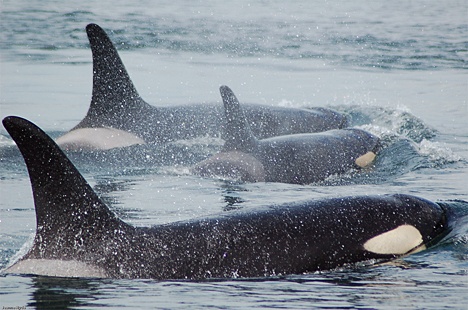There’s one thing it appears everyone can agree on: The Southern Resident killer whales, declared endangered four years ago under federal law, are in need of better protection than they’re getting out on the water today.
Nevertheless, criticism came from nearly all corners on Tuesday as the San Juan County Council gathered input about a recent federal proposal that would create bigger buffers around killer whales in the inland waters of Washington state and that would ban boats, kayaks and canoes (with several notable exceptions) from entering a half-mile “no-go zone” along the southwest shore of San Juan Island.
That no-go zone, as proposed, spans 6.2 miles, from Mitchell Bay to Eagle Cove, and would be in effect May 1 through Sept. 30.
Brian Endres simply wants to continue paddling his kayak off the west side when weather and water conditions allow. Paddling can be hazardous outside the summer months, Endres said, and navigating around a half-mile zone would put a kayaker at risk in the heavily-traveled waters of Haro Strait.
“I don’t want to see this activity that doesn’t seem to be impacting the whales to put us in harm’s way,” he said.
The County Council will meet Monday, at 10:30 a.m., to formulate a response to the newly-proposed federal regulations. At 7 p.m., the National Marine Fisheries Service, tasked with developing and implementing a recovery plan for the Southern Residents, will take public comment on its proposal in a two-hour public meeting at the Grange Hall in Friday Harbor.
Mark Anderson, founder of Orca Relief, said he would allow kayaks and sport fishermen in the no-go zone, saying they have little disruption on the ability of a killer whale to use echolocation and locate prey. Instead, according to Anderson, federal officials should be targeting the “flotilla of boats” that follow the orcas all day long, seven days a week, and which, he insists, pose the greatest risk to the survival of the Southern Residents in the short-term.
Furthermore, he said federal officials already have the authority to crack down on commercial and private whale-watch boats because it is “illegal to pursue an endangered species.” He encouraged the council to press for greater enforcement of federal law as it exists today.
“The problem is with boats staying with the whales all day long,” he said. “They’re dying of starvation and boats accelerate starvation.”
The fisheries service, a division of the National Oceanic and Atmospheric Administration, cites the lack of prey (meaning salmon), pollution and disturbance from vessels as the primary threats to the health and survival of the struggling population, which includes J, K and L pods. The Southern Residents were declared endangered after a six-year decline that drove the population down to 79 animals. The population totals 85 today.
The fisheries service has yet to reveal what steps it will take to remedy the lack of prey or address threats posed by pollution. Killer whales, including the Southern Residents, suffer what many scientists believe may be the highest concentration of toxic chemicals of any animal on the planet because they are the top predator of the sea.
In addition to a no-go zone, new regulations proposed by NMFS would double the distance that a vessel, motorized or not, can approach a killer whale, from 100 yards to 200 yards, and prohibit a vessel from being within 400 yards of an oncoming orca.
San Juan Outfitters’ Brian Goodremont, vice president of the Pacific Whale Watch Association, said there’s an absence of science showing whales would benefit from doubling the distance. He said the association backs the county Marine Resources Committee in supporting a “slow-go” zone, which would prohibit a boat from traveling more than 7 knots, as well as greater enforcement of the 100-yard buffer.
Nearly all “potential” impacts would be corrected with a 7-knot speed limit and better enforcement of existing law, he said. “That would eliminate 99 percent of potential vessel effects,” he said.




